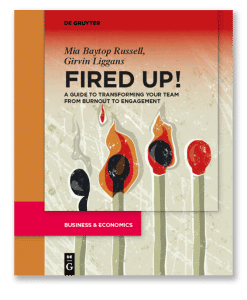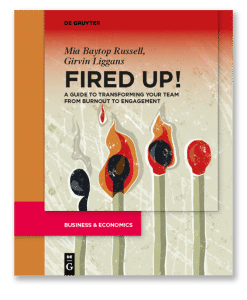Become a burnout risk manager in your organization
In the fight against employee burnout, we can learn a lot from risk managers. Risk managers are curious and are skilled at thinking about how potential decisions, practices and policies can impact future plans. They work diligently to identify risks and to design strategies that prevent potentially harmful activities and practices.
Managing risk is every leader’s responsibility. Consider this:
Every leader — from managers to human resources professionals to senior-level executives — should be a burnout risk manager.
Burnout costs organizations about $300B annually in lost productivity[1] and claims credit for 20-50% of turnover.[2] Burnout is an organizational problem — and one that comes at a significant cost. Organizations must be intentional about building and maintaining a positive and engaged work environment.
To understand what it means to be a burnout risk manager, let’s review what burnout is, what you should look for, and what you can do.
What is Burnout?
Burnout is defined as the result of chronic stressors at work due to overwhelming exhaustion, feelings of cynicism and detachment from the job, and a sense of ineffectiveness and lack of accomplishment. Or in other words, think of burnout as being detached and weighed down by excessive job pressure, stumbling through exhaustion, and walking under a cloud of self-doubt about job performance and overall work success. It is not merely fatigue, depression, feeling anxious, frustrated, or overwhelmed, yet these could all be symptoms.
But symptoms serve as warning signs that you want to attend to.
What should you look out for in your colleagues?
- Emotional and physical drain
- Callous and uncaring attitudes and behaviors
- Reduced involvement at work
- Reduced responsiveness to the needs of others or the demands of work
- Lack of competence and confidence
- Negative reflections of past and present accomplishments at work
Pay close attention to subtle and meaningful changes in your employees’ work habits. For instance, when employees who used to accomplish tasks quickly begin to take more time to complete projects or they begin to fall behind on routine assignments. Or perhaps someone on your team has lost enthusiasm for work. Previously you could count on the employee to offer thoughtful and insightful perspectives in meetings but now this team member barely speaks.
If you see these symptoms, affirm your team and colleagues. Let them know that if they are experiencing burnout, it is not necessarily their fault and that you are ready and willing to provide support. Find out what they may need from you and from the organization.
And, be on the lookout as burnout can be contagious, affecting managers and virtual teams too.
What can you do?
Tackling burnout requires leveraging the complex relationships within the workplace — at the individual, job, and organization level, what we call the Organization, Job-related, and Personal (OJP) framework. Grounded in theory and practical application, the OJP framework guides leaders in cultivating a workplace that — instead of causing burnout — creates a climate of trust, respect and fairness.
These are just a few things a business should weigh when using the OJP framework:
- Consider the organization. Can you modify the physical environment? Can you make the work environment pleasant, more inviting, and collaborative? Can you improve the transparency and frequency of communication?
- Consider the job (role). Are the right people assigned to the right tasks? Is it possible to reassign tasks or redesign roles to spread work across the team — more evenly or more appropriately? Are there ways to improve your team’s workflow, process, or procedures? Are there bottlenecks or cogs in the process?
- Consider the person. How might you build a more meaningful relationship with your team, collectively and individually? Are you leveraging the strengths of each team member? In what ways can you create opportunities for each person on your team to find meaning in their work?
Interactions within the work environment are varied and complex; as such, no one approach fits all situations. The OJP framework offers flexibility — it can help you tailor your approach based on each individual team member’s unique needs as well as develop strategies to comprehensively support your team.
- Three-piece set of hard-side suitcases with...
- Includes 20 inch, 24 inch , 28 inch Upright
- Sturdy ergonomic aluminum telescoping handle
- Due to differences in monitors/screens - Actual...
- 24" SPINNER LUGGAGE maximizes your packing power...
- PACKING Dimensions: 24” x 17.5” x 11.5”,...
- 10 YEAR LIMITED WARRANTY: Samsonite products are...
- MICRO-DIAMOND POLYCARBONATE texture is extremely...
- SIDE-MOUNTED TSA LOCKS act to deter theft,...
Last update on 2024-04-05 / Affiliate links / Images from Amazon Product Advertising API
There is a three-step process for implementing the OJP framework — we call it the three “A’s”:
- Step 1 (Assess): you assess stressors and other aspects of the work environment that were helping and hindering your team. You also identify potential warning signs.
- Step 2 (Acknowledge): you consider internal and external factors influencing your team and organization. You consider what control you have and what types of issues you might meaningfully influence.
- Step 3 (Act): you build a plan, brick by brick. You identify strategies that will help improve your work environment. Some strategies will work, others won’t. It is important that you try different approaches for the benefit of your team.
Each step is critical in achieving quick wins and developing long-term solutions. When your team works in a comfortable environment, they will feel good about being there — and get more done.
Burnout risk managers lead by example. A good leader has the trust of their team. Trust is the currency that builds human connections between leaders and workers. It becomes easier to ensure stability in a team that knows who they are working for and what projects they will be working on. Burnout risk managers motivate their employees, gain their trust, and support their well-being. Whether leaders cultivate a culture of burnout prevention or train employees on the signs and symptoms of burnout, it’s clear that organizations will need to consider burnout for years to come.

Mia Baytop Russell, PhD
Mia is a leadership and management lecturer in the Center for Leadership Education at Johns Hopkins University where she teaches leadership and management courses. Mia has spent decades exploring well-being in multiple contexts and her research focuses on the sustainability of well-being, specifically family economic well-being and career/work-related well-being.
Girvin Liggans, PhD
Girvin Liggans is an expert in policy analysis and a lecturer in the Whiting School of Engineering at Johns Hopkins University where he teaches management, leadership, and technical communication. His research is multidisciplinary and spans environmental health, organizational behavior, legal epidemiology, and diversity and inclusion.
- Compact and Sleek Design: The KAVU Delray Beach...
- Adjustable Shoulder Strap: The bag features an...
- Two Way Zip Closure: The main compartment of the...
- Multiple Pockets: In addition to the main...
- Durable Material: The bag is made from a...
- Samsonite Omni Hardside Luggage 20" Spinner Army...
- Lighter. Stronger. Bolder. Brighter
- Effortless Slotted Spinner Wheel Design | TSA Lock
- Large Organization Pockets | Large expansion...
- BUNDLE INCLUDES: Deco Gear Luggage Accessory Kit...
Last update on 2024-04-05 / Affiliate links / Images from Amazon Product Advertising API
You can learn more about the authors at https://thinkfiredup.com
[1] Original Postayroll-lending-loan-alternatives-finfit-david-kilby/" target="_blank" rel="nofollow noopener" shape="rect">Pymnts.com (2018, Mar 27). The $300B Employee Financial Stress Tax
[2] Moss, J. (2021). Beyond burned out. Harvard Business Review.






